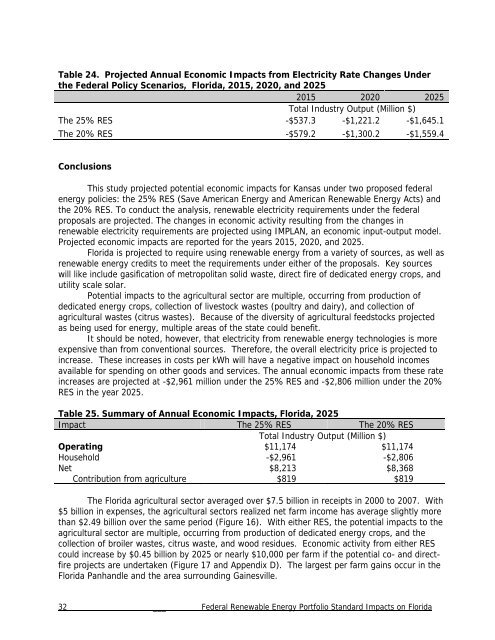Florida Study - Bipartisan Policy Center
Florida Study - Bipartisan Policy Center
Florida Study - Bipartisan Policy Center
Create successful ePaper yourself
Turn your PDF publications into a flip-book with our unique Google optimized e-Paper software.
Table 24. Projected Annual Economic Impacts from Electricity Rate Changes Underthe Federal <strong>Policy</strong> Scenarios, <strong>Florida</strong>, 2015, 2020, and 20252015 2020 2025Total Industry Output (Million $)The 25% RES -$537.3 -$1,221.2 -$1,645.1The 20% RES -$579.2 -$1,300.2 -$1,559.4ConclusionsThis study projected potential economic impacts for Kansas under two proposed federalenergy policies: the 25% RES (Save American Energy and American Renewable Energy Acts) andthe 20% RES. To conduct the analysis, renewable electricity requirements under the federalproposals are projected. The changes in economic activity resulting from the changes inrenewable electricity requirements are projected using IMPLAN, an economic input-output model.Projected economic impacts are reported for the years 2015, 2020, and 2025.<strong>Florida</strong> is projected to require using renewable energy from a variety of sources, as well asrenewable energy credits to meet the requirements under either of the proposals. Key sourceswill like include gasification of metropolitan solid waste, direct fire of dedicated energy crops, andutility scale solar.Potential impacts to the agricultural sector are multiple, occurring from production ofdedicated energy crops, collection of livestock wastes (poultry and dairy), and collection ofagricultural wastes (citrus wastes). Because of the diversity of agricultural feedstocks projectedas being used for energy, multiple areas of the state could benefit.It should be noted, however, that electricity from renewable energy technologies is moreexpensive than from conventional sources. Therefore, the overall electricity price is projected toincrease. These increases in costs per kWh will have a negative impact on household incomesavailable for spending on other goods and services. The annual economic impacts from these rateincreases are projected at -$2,961 million under the 25% RES and -$2,806 million under the 20%RES in the year 2025.Table 25. Summary of Annual Economic Impacts, <strong>Florida</strong>, 2025Impact The 25% RES The 20% RESTotal Industry Output (Million $)Operating $11,174 $11,174Household -$2,961 -$2,806Net $8,213 $8,368Contribution from agriculture $819 $819The <strong>Florida</strong> agricultural sector averaged over $7.5 billion in receipts in 2000 to 2007. With$5 billion in expenses, the agricultural sectors realized net farm income has average slightly morethan $2.49 billion over the same period (Figure 16). With either RES, the potential impacts to theagricultural sector are multiple, occurring from production of dedicated energy crops, and thecollection of broiler wastes, citrus waste, and wood residues. Economic activity from either REScould increase by $0.45 billion by 2025 or nearly $10,000 per farm if the potential co- and directfireprojects are undertaken (Figure 17 and Appendix D). The largest per farm gains occur in the<strong>Florida</strong> Panhandle and the area surrounding Gainesville.32 ___ Federal Renewable Energy Portfolio Standard Impacts on <strong>Florida</strong>


